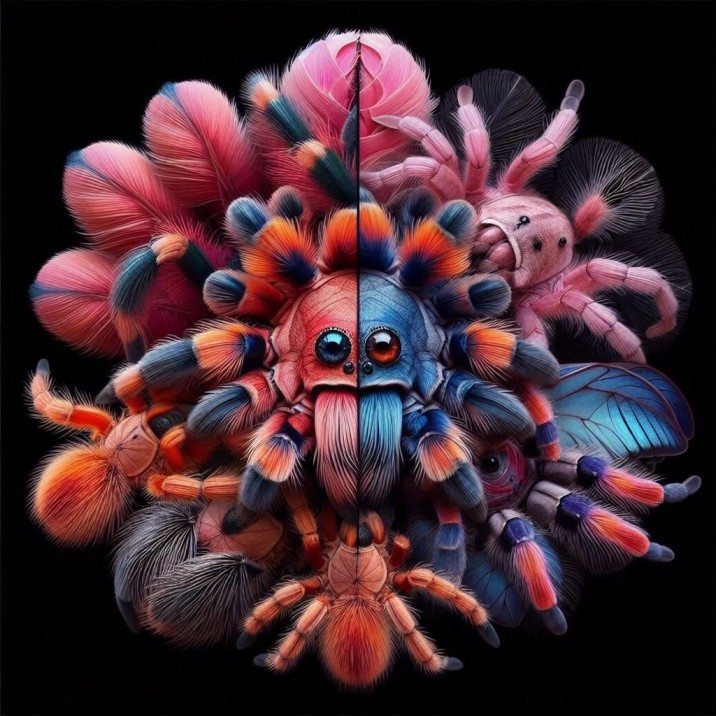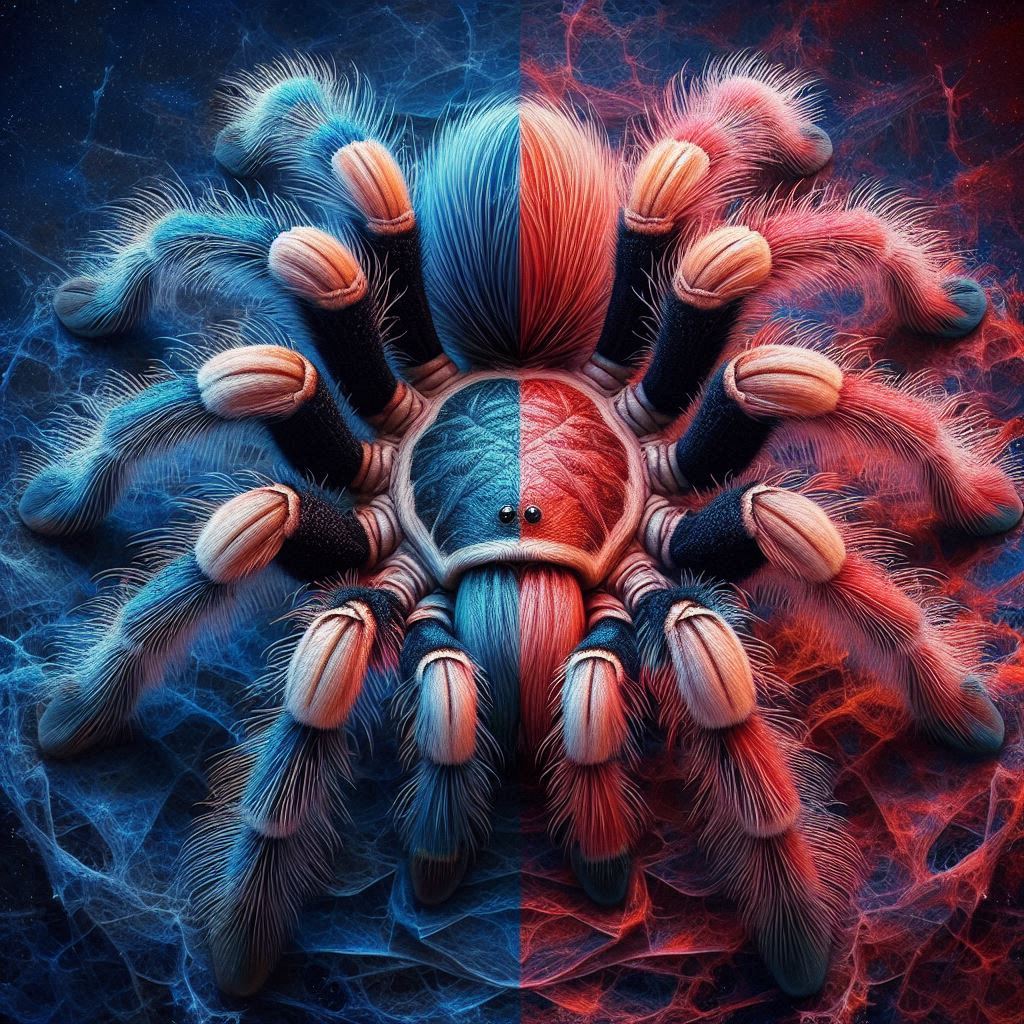Introduction
Table of Contents
Have you ever wondered what color are tarantulas? These fascinating creatures come in a surprising array of colors and patterns. Tarantulas are not just the plain, hairy spiders many people imagine; they boast a variety of hues that can be quite stunning. In this article, we will explore the different colors of tarantulas, why they have these colors, and how they use them in their daily lives. Let’s dive into the colorful world of tarantulas!

The Variety of Tarantula Colors
Tarantulas can be found in a multitude of colors. Here are some of the most common and unique tarantula colors:
Common Colors
Brown and Black
Most tarantulas are brown or black. These colors help them blend into their natural surroundings, such as the forest floor or burrows. This camouflage is essential for avoiding predators and sneaking up on prey.
Grey
Some tarantulas are a shade of grey, which also helps them blend into rocky environments or sandy areas. Grey tarantulas can often be found in deserts or areas with lots of stones.
Unique and Vibrant Colors
Blue
The Gooty Sapphire Ornamental Tarantula is one of the most famous blue tarantulas. Its bright blue color is a result of microscopic structures in its hair that reflect blue light. These tarantulas are native to India and are highly sought after by collectors.
Green
The Greenbottle Blue Tarantula has a vibrant green color mixed with other hues. Found in Venezuela, this tarantula’s colorful appearance includes a metallic green carapace, blue legs, and an orange abdomen.
Red and Orange
The Mexican Redknee Tarantula is known for its striking red or orange knees. These bright colors can serve as a warning to potential predators, signaling that the tarantula might be dangerous.
Pink
The Brazilian Salmon Pink Birdeater is one of the largest tarantulas and has a pinkish hue on its legs. This color can help it blend into its surroundings at dawn and dusk when it is most active.
Yellow
Some tarantulas, like the Singapore Blue, have yellow bands or stripes on their legs. These markings can help them camouflage among leaves and trees in their tropical habitats.
Why Do Tarantulas Have Different Colors?
Camouflage
One of the primary reasons for the varied colors of tarantulas is camouflage. By blending into their environment, tarantulas can avoid predators and ambush their prey more effectively.
Warning Signals
Bright colors like red, orange, and yellow can serve as warning signals. These colors indicate to potential predators that the tarantula might be venomous or dangerous.
Mating and Attraction
Color can also play a role in mating and attraction. Male tarantulas often use their colors to attract females during the mating season. The brighter and more vibrant the color, the more likely they are to catch the attention of a potential mate.
How Do Tarantulas Change Colors?
Tarantulas can change color through a process called molting. As they grow, they shed their old exoskeleton and reveal a new, often more vibrant one underneath. This new exoskeleton can have different colors and patterns compared to the old one.
The Molting Process
- Preparation: The tarantula prepares for molting by stopping eating and becoming less active.
- Shedding: The tarantula flips onto its back and begins to shed its old exoskeleton.
- New Exoskeleton: After shedding, the new exoskeleton is soft and vulnerable. It takes several days to harden and display its true colors.
Examples of Colorful Tarantulas
Gooty Sapphire Ornamental Tarantula
- Scientific Name: Poecilotheria metallica
- Color: Vibrant blue
- Habitat: India
- Description: This tarantula is known for its bright blue color, which is rare in the animal kingdom. The blue color is due to structural coloration, not pigments.
Mexican Redknee Tarantula
- Scientific Name: Brachypelma smithi
- Color: Black with red or orange knees
- Habitat: Mexico
- Description: The Mexican Redknee is famous for its striking red knees, which it uses to warn predators of its venomous bite.
Greenbottle Blue Tarantula
- Scientific Name: Chromatopelma cyaneopubescens
- Color: Green carapace, blue legs, orange abdomen
- Habitat: Venezuela
- Description: This tarantula’s colorful appearance makes it a favorite among tarantula enthusiasts. Its green and blue colors are particularly vibrant.
Brazilian Salmon Pink Birdeater
- Scientific Name: Lasiodora parahybana
- Color: Pinkish hairs on legs
- Habitat: Brazil
- Description: One of the largest tarantulas, it has a pinkish hue that helps it blend into its environment during dawn and dusk.
Table of Information
| Tarantula Name | Scientific Name | Color | Habitat | Unique Feature |
|---|---|---|---|---|
| Gooty Sapphire Ornamental Tarantula | Poecilotheria metallica | Vibrant blue | India | Bright blue color due to structural coloration |
| Mexican Redknee Tarantula | Brachypelma smithi | Black with red or orange knees | Mexico | Striking red knees |
| Greenbottle Blue Tarantula | Chromatopelma cyaneopubescens | Green carapace, blue legs, orange abdomen | Venezuela | Colorful appearance with green and blue hues |
| Brazilian Salmon Pink Birdeater | Lasiodora parahybana | Pinkish hairs on legs | Brazil | One of the largest tarantulas |
Conclusion
Tarantulas are more colorful and diverse than many people realize. From the vibrant blues of the Gooty Sapphire Ornamental Tarantula to the striking red knees of the Mexican Redknee Tarantula, these creatures use their colors for camouflage, warning signals, and mating. Understanding what color are tarantulas can give us greater appreciation for these fascinating creatures. Whether you’re a spider enthusiast or just curious, the colorful world of tarantulas is full of surprises.
FAQ’s about What color are Tarantulas
1. What is the most colorful tarantula?
The Gooty Sapphire Ornamental Tarantula is considered one of the most colorful tarantulas due to its vibrant blue color.
2. Why do tarantulas have bright colors?
Bright colors can serve as warning signals to predators, indicating that the tarantula might be venomous or dangerous.
3. How do tarantulas change their color?
Tarantulas change color through molting, where they shed their old exoskeleton and reveal a new, often more vibrant one underneath.
4. Are there pink tarantulas?
Yes, the Brazilian Salmon Pink Birdeater has pinkish hairs on its legs.
5. Do all tarantulas have the same color?
No, tarantulas come in a variety of colors including brown, black, grey, blue, green, red, orange, pink, and yellow.

